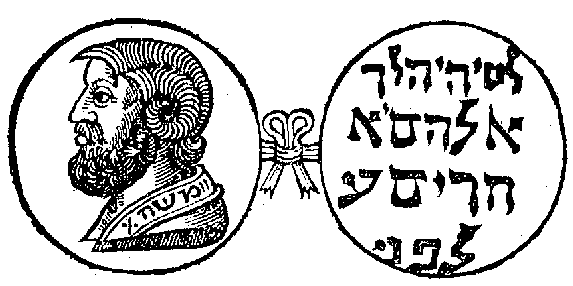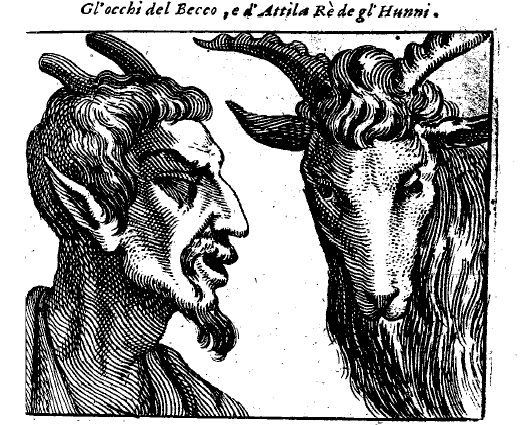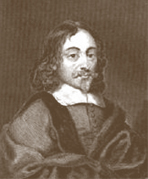Chap. IX.
Of the Picture of Moses with Horns.
IN many pieces, and some of ancient Bibles, Moses is described with horns.[1] The same description we finde in a silver Medal; that is, upon one side Moses horned, and on the reverse the commandment against sculptile Images. Which is conceived to be a coynage of some Jews, in derision of Christians, who first began that Pourtract.[2]
The ground of this absurdity, was surely a mistake of the Hebrew Text, in the history of Moses when he descended from the Mount;3 upon the affinity of Kæren and Karan, that is, an horn, and to shine, which is one quality of horn: The Vulgar Translation conforming unto the former. Ignorabat quod cornuta esset facies ejus. Qui videbant faciem Moses esse cornutam. But the Chaldee paraphrase, translated by Paulus Fagius, hath otherwise expressed it. Moses nesciebat quod multus esset splendor gloriæ vultus ejus. Et viderunt filii Israel quod multa esset claritas gloriæ faciei Moses. The expression of the Septuagint is as large, δεδόξασται ἡ ὄψις τοῦ χρώματος τοῦ προσώπου, Glorificatus est aspectus cutis, seu coloris faciei.
And this passage of the Old Testament, is well explained by another of the New;4 wherein it is delivered, that they could not stedfastly behold the face of Moses, Διὰ τὴν δόξαν τοῦ προσώπου; that is, for the glory of his countenance. And surely the exposition of one Text is best performed by another; men vainly interposing their constructions, where the Scripture decideth the controversie. And therefore some have seemed too active in their expositions, who in the story of Rahab the harlot,[5] have given notice that the word also signifieth an Hostess; for in the Epistle to the Hebrews, she is plainly termed πόρνη,[6] which signifies not an Hostess, but a pecuniary and prostituting Harlot;7 a term applyed unto Lais by the Greeks, and distinguished from ἕταιρα, or amica, as may appear in the thirteenth of Athenæus.
And therefore more allowable is the Translation of Tremellius,[8] Quod splendida facta esset cutis faciei ejus; or as Estius hath interpreted it, facies ejus erat radiosa, his face was radiant, and dispersing beams like many horns and cones about his head; which is also consonant unto the original signification, and yet observed in the pieces of our Saviour, and the Virgin Mary, who are commonly drawn with scintillations, or radiant Halo's about their head; which after the French expression are usually termed, the Glory.
Now if besides this occasional mistake, any man shall contend a propriety in this picture, and that no injury is done unto Truth by this description, because an horn is the Hieroglyphick of authority, power and dignity, and in this Metaphor is often used in Scripture;[9] the piece I confess in this acception is harmeless and agreeable unto Moses: and under emblematical constructions, we finde that Alexander the Great, and Attila King of Hunnes, in ancient Medals are described with horns.[10] But if from the common mistake, or any solary consideration we persist in this description; we vilify the mystery of the irradiation, and authorize a dangerous piece conformable unto that of Jupiter Hammon; which was the Sun, and therefore described with horns; as is delivered by Macrobius;[11] Hammonem quem Deum solem occidentem Lybies existimant, arietinis cornibus fingunt, quibus id animal valet, sicut radiis sol. We herein also imitate the Picture of Pan, and Pagan emblem of Nature. And if (as Macrobius and very good Authors concede) Bacchus, (who is also described with horns) be the same Deity with the Sun,[12] and if (as Voßius well contendeth)13 Moses and Bacchus were the same person; their descriptions must be relative, or the Tauricornous picture of the one, perhaps the same with the other.
NOTES
*My (or others') notes are in [brackets]; additional material by Browne from manuscripts or previous editions is in {braces}; Browne's original marginalia are not specially marked. Ross defends the painters, rather weakly, Arcana Microcosmi, Book II, Chap. 11. By this point in his work, Ross simply attacks anything Browne says, often using Browne's own arguments.
1 [Very widespread in medieval and early Renaissance portraiture; indeed, it becomes an iconographic point, enabling us to identify Moses as easily as, say, Lawrence with his gridiron, Catherine with her wheel, and so on. The representation was beginning to die out by Browne's day. The most widely known examples today are Michelangelo's statue in Rome and Sluter's (earlier) figure of Moses on the Well of Moses in Dijon, but there are examples in the glass of French cathedrals, including Chartres, Paris, and Bourges. (The Chartres window shows a horned (and haloed) Moses with the brazen serpent. The sculpture on the door shows Moses, again with the brazen serpent, but without horns (still haloed, however). Moses is also depicted in two other windows in the church, again with horns.) The earliest examples are found in an eleventh-century manuscript of Ælfric's Paraphrase (also known as the Old English Heptateuch), where Moses is shown in a sort of hat with horns (which, by the way, eliminates the oft-asserted origin in the Rouen mystery plays of the 14th century). See Ruth Mellinkoff's The Horned Moses in Medieval Art and Thought for a treatment of the subject; see also Margit Süring's dissertation, published as "The Horn Motif" (1980, Andrews University Press) for a general discussion of the religious connotations of horns, and a bibliography.]

Moses talks to God in the burning bush (he shouldn't have horns yet, since he gets them only later, but there they are).
2 [Selden (1640) De Iure Naturali & Gentium, Iuxta Disciplinam Ebræorum, describes such a coin, pp. 191-196:

Selden translates the reverse: interdictum est sic facere imaginem humanum. He says that the coin is odd and not easily understood, and goes on "In pictura scilicet Christianorum qui ex eo quod in vulgata habetur de Mose, ignorabat quid cornuta esset facies sua, & videbat faciem egredientis Moysi esse cornutam bicornum Mosem pingunt", and follows by a discussion of the translation. The illustrated medal or coin is similar to coins of Alexander the Great wearing the horns of his ancestor Ammon (except that Alexander is not bearded): for examples, see Ancient Coins of the Macedonian Kingdom, Portraits of Alexander, Alexander the Great, and so on.]
3 Exod. 34.29, 35. [The Hebrew word קרן, the Hebraicists tell us, is a Qal verb form (i.e., "Perfect" state) and occurs as such only in this passage. It cannot be (properly) translated by the English "with horns"; Ælfric translates the Latin cornuta as "gehyrned", "behorned". The Septuagint has δεδόξασται; Aquila, as Ross says, has κερατώδης ἦν. That Jerome did not mean anything that we would call "horns" is usually demonstrated by a passage from his Commentary on Ezechial: "denique post quadraginta dies, vultum Moysi vulgus ignobile caliganttibus oculis non videbat, quia 'glorificata erat,' sive, ut in hebraico continetur, 'cornuta', facies Moysi". See Mellinkoff, pp. 77-87, for a discussion of the horns from the perspective of translators and commentators. Süring (page 428) points out the improbability of Moses' being ignorant of horns, which, as she also remarks, are said to come not from the forehead, but from the face.]
4 2 Cor. 3.[7-8:
But if the ministration of death, written and engraven in stones, was glorious, so that the children of Israel could not stedfastly behold the face of Moses for the glory of his countenance (in the Vulgate "propter gloriam vultus eius"); which glory was to be done away:
8. How shall not the ministration of the spirit be rather glorious?]
5 [Joshua 2 and 6. In a story that must have delighted Voltaire, Rahab betrays her city by harboring spies sent by the Israelites; she and her family are the only inhabitants of Jericho saved in its utter destruction (except the vessels of silver, of gold, and of brass and of iron, which are transported to the treasury). The moral is not entirely clear; or, rather, the clear moral cannot be what we are intended to take away from the story.]
6 [Heb 11:31]
7 What kind of Harlot she was, reade Camar. De vita Eliæ.
8 [The Biblia Sacra (1587, i. p. 87) version of 34:29 reads "Fuit verò descendente Mosche e monte Sinai, quum essent duae illae tabulae testimonii in manu Moschis, descendendo ex monte illo; ut ignoraret Mosche splendidam esse factam cutem faciei suae, quum ille loqueretur secum." A note on the clause "ut ignoraret..." refers us to the passage from Corinthians cited above.]
9 [On the various meanings of the horn, see Süring, pp. 313 ff. There are nearly one hundred instances of "horn" or "horns" in the Bible; representative passages include Deut. 33:17 (of Joseph): "His glory is like the firstling of his bullock, and his horns are like the horns of unicorns: with them he shall push the people together to the ends of the earth: and they are the ten thousands of Ephraim, and they are the thousands of Manasseh"; 2 Chr. 18:10 "And Zedekiah the son of Chenaanah had made him horns of iron, and said, Thus saith the Lord, With these thou shalt push Syria until they be consumed" (identical to 2 Kings 22:11); Psalms 75:4-5, 69:31, etc. Probably the closest to Exodus 34 is Habakkuk 3:4; in the KJV, "And his brightness was as the light; he had horns coming out of his hand: and there was the hiding of his power", where "horns" (קרנים) is a dual noun rather than a verb; the RSV translates "His brightness was like the light, rays flashed from his hand; and there he veiled his power", the Vulgate "splendor eius ut lux erit cornua in manibus eius ibi abscondita est fortitudo eius". In Job 16:15 (KJV: "I have sewed sackcloth upon my skin, and defiled my horn in the dust", the RSV "I have sewed sackcloth upon my skin, and have laid my strength in the dust"; the Vulgate (as 16;16) "saccum consui super cutem meam et operui cinere cornu meum"; the New American Bible "have laid my brow in the dust") the horn is felt to represent strength, and by some translators to be connected with the head.]
10 [Coins bearing horned Alexander were mentioned above. Attila is shown with horns in, e.g., G.B. della Porta's Physiognomonia; in the 1652 Italian translation, p. 395:

11 [Macrobius, Saturnalia I.21.19.]
12 [Pan, emblem of Nature: Macrobius I.22.2-7; Bacchus/Apollo = the Sun, Macrobius I.18.5 ff., and concluding with 24.]
13 Moses and Baccus supposed to be the same person. De origine Idolatriae. [in his Theologia Gentili.]
This page is dedicated to the memory of Boo the Cat.
